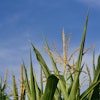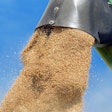
Offering the latest education on U.S. corn — from crop quality to storage solutions for challenging environments — is at the forefront of the U.S. Grains Council’s mission of developing markets, enabling trade and improving lives.
As evidence of this, USGC recently published its 2021/2022 Corn Harvest Quality Report to showcase this year’s crop to buyers around the globe.
The report, released in December, revealed this past year’s corn crop has a higher average test weight and lower total damage and stress cracks compared to the previous five crops.
“USGC has been providing the report every year for the last 11 years,” says Dr. Kyle Gilliam, USGC manager of global strategies and trade.
“Our reports consistently show that the U.S. produces an abundance of good quality corn. This year’s report is no different with this crop being one of the better crops since we started our report in 2011.”
Corn quality report
The report, based on 610 samples taken from defined areas within 12 of the top corn-producing and exporting states, showed the 2021 crop was planted earlier than average and experienced a mostly warm growing season. Overall, 65% of the crop rated a good or excellent condition, nearing record-high yields.
The average aggregate quality of the representative samples tested was better than the grade factor requirements for U.S. No. 1 grade. The report also showed that 90% of the samples met the grade factor requirements for U.S. No. 1 grade and 98% met the grade factor requirements for U.S. No. 2.
This year’s crop also showed lower average broken corn and foreign material (BCFM) than the five-year average; lower average total damage than the five-year average; and a similar average moisture content compared to the five-year average.
The report showed this crop had lower-than-average protein concentration than the five-year average; lower average stress cracks than 2020 and the five-year average; and a similar average 100-kernel weight compared to the five-year average.
Nearly 99% of the samples tested below the U.S. Food and Drug Administration (FDA) action level for aflatoxins.
A full 100% of the samples tested below the 5.0 parts per million FDA advisory level for deoxynivalenol (DON) or vomitoxin. Of the samples tested for fumonisin, 97.2% tested below the FDA’s strictest guidance level of 5.0 parts per million.
The 2021/2022 U.S. corn crop is expected to be the second largest (382.6 million metric tons/15,062 million bushels) on record. It also has the highest average yield on record (11.11 metric tons per hectare or 177 bushels per acre), according to the U.S. Department of Agriculture (USDA) World Agricultural Supply and Demand Estimate (WASDE).
The 2021/2022 Corn Harvest Quality Report provides information about the quality of the current U.S. crop at harvest as it enters international merchandising channels.
A second USGC report, the 2021/2022 Corn Export Cargo Quality Report, available in spring 2022, will measure corn quality at the point of loading for export.
The full report can be viewed at grains.org/corn_report.
Egyptian storage project
While USGC is dedicated to sharing the latest information on U.S. corn quality to buyers and end-users, education goes beyond printed reports.
Working with customers on the ground to identify a problem and solve it firsthand sets USGC apart when promoting the advantages of its member-produced commodities.
Recently, in Egypt, USGC helped tackle concerns about long-term storage of U.S. corn in the country’s hot, humid environment, working with Dr. Klein Ileleii from Purdue University to conduct a corn storage program to improve conditions and the overall storability of U.S. corn there.
Throughout 2022, USGC will gather data from a warehouse owned by the largest corn importer in Egypt, where USGC-sponsored aeration equipment has been installed.
The data collected will be compared to a warehouse that does not use the equipment to show the economic and grain quality benefits of using these mechanisms in storage facilities.
Gilliam visited Damietta, Egypt, in November 2021 to assist in the storage project and worked closely with the Egyptian importer while there.
Using a grant from the Missouri Corn Growers Association, aeration equipment that uses standalone pedestals in flat warehouses was installed in one of the 24 storage facilities. The Egyptian government only allows flat storage at the port, making this style of equipment a necessity.
“Egypt is a 10 million metric ton (MMT) per year import market,” Gilliam says. “With this program and the continued relationship with the grains importing leader, combined with USGC’s industrial starch program highlighting the superior performance of U.S. corn in wet milling, we were able to see four vessels of U.S. corn traded into Egypt last year — approximately a $60 million investment.
“The hope with this program is to show the Egyptians how they can properly store U.S. corn and anchor at least 1 MMT of exports to Egypt annually.”
The corn storage project will continue for one year in Egypt as USGC gathers data. Additionally, USGC plans to roll out this program in other countries and companies around the world where storage conditions negatively impact the image of U.S. corn.
Wet milling project
Complementary to the storage program, in 2019, USGC worked in Egypt to conduct a starch program that focused on how industrial wet millers can see an increased profit from using U.S. corn over that of other origins.
To help one of the most renowned companies in Egypt improve its industrial starch plants’ operations, USGC connected the Cairo-based company with high-level starch consultant, Dr. Vijay Singh of the University of Illinois.
“Dr. Singh’s consultation began in 2019 as he helped the starch producers evaluate their facilities and identify processes that could improve their overall operations and plant profitability,” Gilliam says.
“The results of USGC’s industrial corn starch study were shared with the starch company via a virtual conference in 2020. The findings showed that U.S. corn can extract 3% to 4% higher yields of starch versus corn of other origins, which can have a significant impact on the plant’s overall profitability.”
In June 2021, Dr. Singh and Gilliam traveled to Cairo to help the Egyptian starch company understand the technology and science associated with corn wet milling through an audit that analyzed the starch extractability of U.S.-origin corn.
The study’s results show that starch companies processing 1,500 metric tons per day of corn can gain about $1 million in additional profit for every 1% of increase in starch yield. But to reach that gain, technology must be optimized.
Through one-on-one meetings and tours of the facilities, Dr. Singh was able to review the company’s procedures, collect samples and provide specific recommendations for improving its wet milling operations. Optimization of the wet milling process also allowed for the discussion of U.S. corn benefits.
“Dr. Singh’s technical expertise helped provide reassurance that U.S. corn and coproducts are an available and reliable source in Egypt,” Gilliam says. “We are working to continue to build long-term trust in this competitive market.”
Through programming and projects in regions around the world, USGC continues to exhibit the quality of U.S. corn while building trust in their markets.
Corn sales to Egypt increased by 830% in the 2020/2021 marketing year for a total of 451,500 metric tons, or 17.7 million bushels. Egypt is the second-largest market for U.S. corn in the Middle East region. ■

















